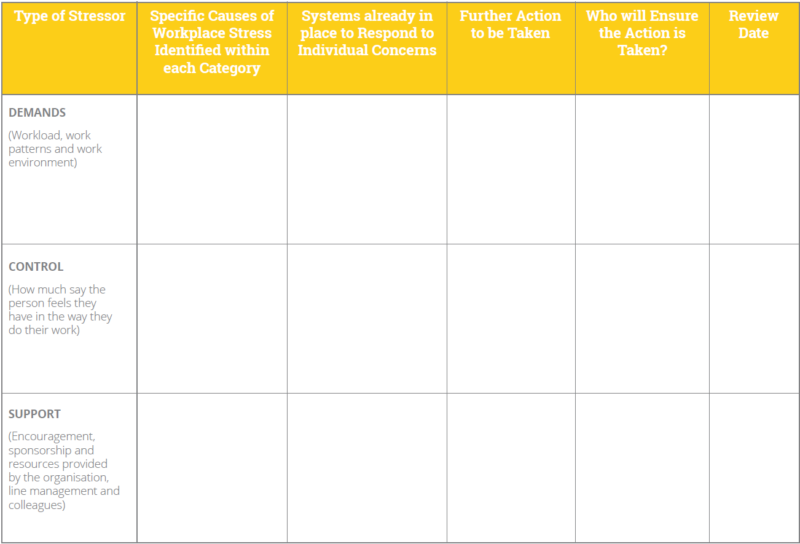Workplace stress, pressure and burnout are becoming increasingly common in today's workplaces. For both employers and employees, the impact is far-reaching, affecting productivity, morale, and overall wellbeing.
One of the most effective ways to tackle this is by embedding stress risk assessments into everyday workplace practice.
A stress risk assessment is a proactive tool that helps to identify potential stressors before they escalate. It opens up space for meaningful conversations, early intervention, and support. By understanding what is contributing to someone’s stress, we can create environments where people feel heard, supported, and can thrive.
This guide will explore how to implement stress risk assessments effectively. It will provide examples and templates to streamline the process and help you to embed a mentally healthy workplace.
Please note: The purpose of a stress risk assessment is not to assess an individual’s mental health. Instead, it’s about identifying factors in the workplace that may be contributing to stress, so that supportive and practical steps can be taken.
When should you complete a stress risk assessment?
It is recommended that managers complete team stress risk assessments annually or every 6 months. If a team member shares that they’re experiencing work related stress, it’s important to respond promptly by completing an individual stress risk assessment.
Understanding Stress in the Workplace
Definition of workplace stress
According to the World Health Organisation (WHO), stress can be defined as a state of worry or mental tension caused by a difficult situation.
When people feel stressed, they make two main judgments. First, they feel threatened by the situation (source), and second, they believe they are unable to meet the threat. How stressed someone feels depends on how much they perceive the situation can hurt them, and how closely they perceive their resources meet the demands of the situation.
Causes of workplace stress
The Health and Safety Executive (HSE) Management Standards cover six areas of work design that, if not properly managed, are associated with poor health, lower productivity and increased accident and sickness absence rates. The HSE Management Standards are as follows:
- Demands – this includes issues such as workload, work patterns and the work environment
- Control – how much say the person has in the way they do their work
- Support – this includes the encouragement, sponsorship and resources provided by the organisation, line management and colleagues
- Relationships – this includes promoting positive working to avoid conflict and dealing with unacceptable behaviour
- Role – whether people understand their role within the organisation, and whether the organisation ensures that they do not have conflicting roles
- Change – how organisational change (large or small) is managed and communicated in the organisation
Importance of Stress Risk Assessments
Stress risk assessments are pivotal in creating a supportive work environment. They enable employers, managers and health and safety professionals to identify stressors and take appropriate actions.
The benefits of work related stress risk assessments include:
- Increased employee engagement
- Stronger workplace relationships
- Early identification of stressors at an organisational level
- Timely support and intervention
- Reduced workplace stress
- Improve mental health and wellbeing
- Lower presenteeism
- Fewer absences
- Reduced staff turnover
- Better employee retention
Components of a Workplace Stress Risk Assessment
Think of a physical health risk: for example, if there’s a known trip hazard in the workplace, it’s standard practice to complete a risk assessment. This helps prevent injury, protect employees, and reduce the risk of litigation. An employer would take reasonable steps, like signage or barriers, to manage the hazard. The same principle applies to work related stress. If we can identify stress triggers early, we can take steps to reduce harm, support wellbeing, and create a more sustainable working environment. A well-rounded stress risk assessment involves several key components that allow for a clear and practical understanding of what’s contributing to stress at work:
- Identification of Stressors
- Review of Existing Support Systems
- Developing an Action Plan
Step-by-Step Guide to Conducting a Stress Risk Assessment
Creating and using a stress risk assessment template helps standardise the process across teams and departments. It streamlines data collection, makes it easier to spot patterns, and supports a consistent approach to managing work related stress.

Identification of Stressors
Start by identifying what’s contributing to stress in your workplace. The HSE Management Standards are a helpful framework for this. For each area, such as Demands, Control, Support, Relationships, Role, and Change, note specific examples.
Stress risk assessment example: Under 'Change', you might write: "A new IT system is being introduced, creating uncertainty and training gaps."
Review of Existing Support Systems
Consider what policies, resources, or initiatives are already in place to help manage or reduce stress. This step helps identify what’s working well and where there may be gaps that need addressing.
Stress risk assessment example (Change): If a new IT system is being introduced, check whether there are support systems in place to ease the transition, such as clear communication plans, training sessions, or a named point of contact for questions. If these don’t exist, this could contribute to feelings of uncertainty or overwhelm, and may signal the need for additional support.
Developing an Action Plan
After identifying stressors, create a clear, practical action plan. Each action should include:
- What will be done
- Who is responsible
- When it will be reviewed
Stress risk assessment example (Change): If a new IT system is causing stress, actions might include scheduling training, offering drop-in support, and assigning a team ‘change champion’. The IT lead may take responsibility, with a review set one month after rollout.
How Altruist Can Help
Our Mental Health Training for Managers equips leaders with the practical skills, tools, and templates they need to confidently conduct stress risk assessments.
By empowering managers to identify and address workplace stress early, we help create healthier, more resilient teams.
To learn more about our managers mental health training, use our contact form, email us at info@altruistuk.com or call us on 0121 271 0550.


